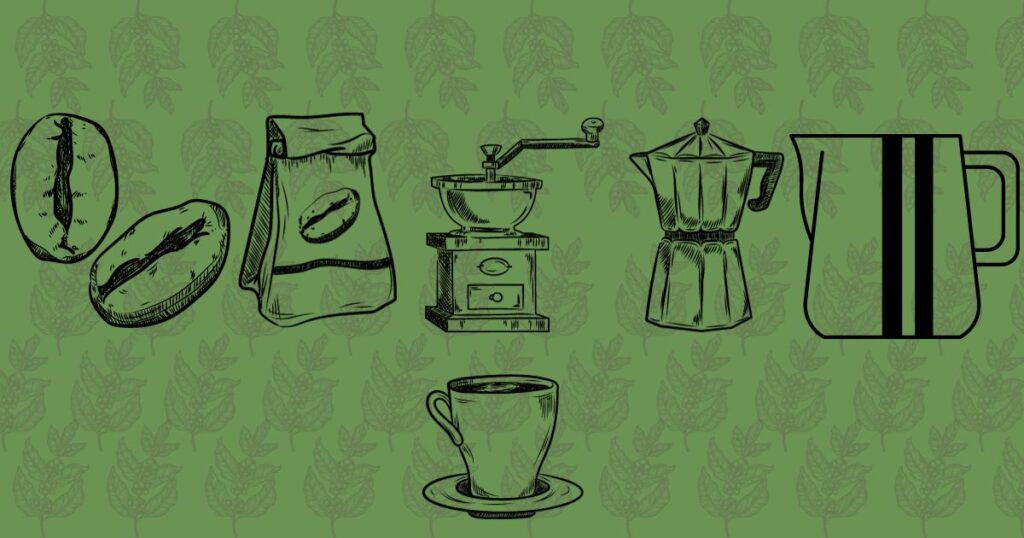Many coffee lovers (me included) take their coffee with a splash of creamer that really adds a layer of extra taste to our brew. But why is my coffee creamer occasionally chunky? What causes that and how can I fix it? Let’s take a look at what are the main reasons that make coffee creamer chunky and we also share valuable hints and tips along the way.
Key takeaways:
- 5 common reasons that turn your creamer chunky
- Solutions discusses in each occasion to avoid chunky creamer
- Easy ways to instantly tell that your coffee creamer has gone bad
5 common reasons that make your coffee creamer chunky
Let’s face it, nobody likes it when they’re really craving a delicious cup of coffee with some coffee creamer or whipped cream, but it turns out that the coffee creamer used for frothing becomes chunky with lumps floating in your cup making it impossible to drink. It’s vital to know how to froth creamer.
Here are four common ways that make your creamer chunky.
1. High coffee acidity can make creamer curdle
High acidity makes your creamer curdle and changes the taste of it; it makes it sour. It causes something that’s called casein
If your creamer has high in acidity try one of the natural methods below to bring the acidity down:
- Put a tiny pinch of salt in it: salt brings down the acidity. But make sure you add just a small portion; otherwise your coffee will become salty (no one like this).
- Add some baking soda: Did you know that baking soda is used in champagne to bring down the acidity? Why not try it with your creamer?
- Go for dark roast coffee beans: Dark roasts are less acidic than the light, so if you make coffee with dark roasts it balances the level of acidity.
- Sprinkle your ground coffee in eggshells: it’s probably the weirdest tip out of all of them but it works because they’re alkaline which practically means they reduce the coffee acidity.
Once you get rid of the inside and clean the eggshells with water,crush them, mix them up with your ground coffee, put them in your coffee basket and brew coffee as normal.
2. High temperature turns your coffee creamer chunky
The milk proteins in every coffee creamer clump together when sudden temperature changes happen, and – you guessed it – your coffee creamer becomes chunky. For example, if you pour hot coffee over cold coffee creamer, the odds are the creamer will curdle.
The trick is to have the coffee and creamer mixed at about the same temperature. If the coffee is too hot, give it a few minutes before pouring, add the creamer or you can heat up the creamer before adding it to the coffee.
Top coffee creamer tip: Powdered coffee creamer isn’t the best for cold coffee; it often curdles. Ideally, go for a creamer in liquid form that dissolves much better.

3. Is the water you use for brewing too acidic?
Does the water you use for brewing smell or does it has unpleasant odours? In different locations water is more acidic than others, and that means that it’s high in toxins and bacteria and that may cause your creamer curdling. To ensure the water in your house isn’t too acidic you can measure its PH with testing strips that won’t cost you a lot.
But in order to prevent water ruining your brew, just use bottled or filter water that won’t make your creamer curdle.
4. Chunky creamer may indicate a spoiling of the creamer
How many days has your creamer been open? If it’s been open for some time and bits of it are floating in your cup, the chances are the creamer has gone off. Another way that shows that’s gone bad is the smell and taste of it. If it has an unusual smell and taste just throw it away and buy a new one.
Liquid dairy creamers only last for a week or two after being opened; they last about five days after being opened. When it comes to non-dairy creamers they don’t last long either, and you should pop them in the fridge after opening them.
Another thing to keep in mind if your coffee is spoiled – no one wants to drink expired coffee.
5. Sugar can turn your creamer into chunky
Disclaimer: If you take your coffee without sugar, skip this paragraph and move to the next one. If not, stick around.
Research suggests that when you mix creamer with sugar it turns sour, curdles and it doesn’t taste good in your coffee. But when you add the sugar to the brewed coffee and then add the creamer it works absolutely fine. If you take your coffee without sugar, skip this paragraph and move to the next one.
Here’s a table that summarises the 5 reasons that make your coffee creamer chunky:
| Problem: | Best Solution: |
| High acidity in coffee | Use dark roast coffee beans |
| High brewing temperature | Give it a few minutes and then pour the creamer in |
| Acidic water | Use bottled or filter water |
| Spoiled creamer | Buy a new creamer |
| Too much sugar in your coffee | Reduce sugar |
How can you tell if your coffee creamer has gone bad?
Let’s talk about both forms of coffee creamer.
- Liquid creamers: You should keep an eye out for texture changes in liquid creamers (clumps, liquid turning chunky), smell changes (sour or off-smelling), and clearly flavour changes. Drink a teaspoon of your coffee; if you’re concerned that it could be past its prime it’s no good risking using it, just throw it away.
- Powder creamers: Watch out for textural changes and mould. The powder should be OK for years, unless moisture gets into the box. Brewing a test cup of coffee is the best way to tell whether a powdered creamer has gone bad. The powder is acceptable if everything tastes good. Throw the package away if the flavour is just a little off.

What’s the reason that my coffee creamer isn’t dissolving?
You’re not alone, it’s happened to me a few times to desperately try to make creamer dissolve.
Here’re a few nifty tips:
Coffee creamer in powder form doesn’t dissolve in cold coffee, so if you’re planning to make a chilled brew, it’s wise to use creamer in liquid. You can use either creamers to pour it over hot coffee, it’ll work just fine.
Why is my almond creamer separating in my coffee
If almond is your favourite milk, you’ve probably come across this problem: You’re about to gulp your freshly made hot coffee and right after pouring a splash of almond milk you realise that it’s curdled and separates from your coffee. It’s no good getting through this ordeal; let’s talk about a few tips.
According to a number of publications, the temperature and acidity of the coffee are the main causes of almond milk’s tendency to curdle when mixed with black coffee.
There’s a larger possibility that the almond milk won’t split in the coffee if you let it cool for a while or warm the almond milk, but it’s not a guarantee.
Does coffee creamer need to be refrigerated
It’s important to keep your creamer in the fridge (especially if it’s dairy) once you open it, which is a recommendation that you’ll come across on the package ‘refrigerate after opening’.
When it comes to mini sealed cups, you can keep them in a cupboard at room temperature, but make sure they’re not exposed to heat or moisture and you’re good.
Is it OK to drink curdled cream in coffee?
Technically, the answer is “Yes” old milk that has curdled is poisonous and dangerous to consume. However, if a chemical reaction causes the curdling, it is still safe to consume even though it doesn’t taste as good as a recently opened creamer. I wouldn’t run this risk considering that it doesn’t cost a lot to buy a new creamer. Plus, who wants to add to their brew if its taste isn’t good enough.
Coffee lover gives his opinion on whether he would drink coffee with lumpy creamer that smells ok:
Likely yes – because cream clusters on storing – i.e. it naturally thickens as it ages.
Particularly if it dries out a little if in an open top jug etc. …If it smells fine, and the lumps disperse on stirring – and it tastes fine – then no problem. Especially if it’s within shelf-life and ha been stored correctly in accord with the recommendations..
– Paul Hart
Wrapping up
So there you have it, It should be one of those four reasons your coffee creamer curdles and doesn’t make the perfect coffee for you. You now know how to make the best coffee, next time if your coffee you brewed isn’t still not good enough it’s not. It’s a life-changing article. You’re now able to brew a great cup of coffee. No more excuses and no more bits floating in your coffee.

- How to Remove Coffee Stains From Countertop The Easy Way - December 21, 2023
- Can You Reuse Coffee Grounds in French Press? Truth Inside - December 12, 2023
- Can Expired Coffee Creamer Make You Sick? 3 Ways to Find Out - December 9, 2023
